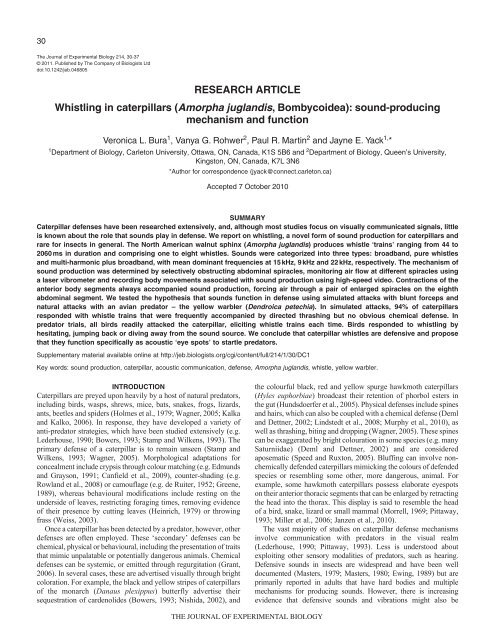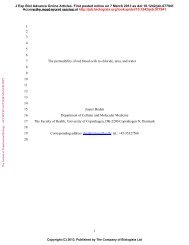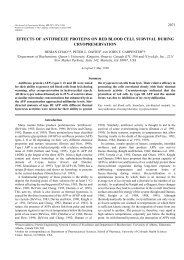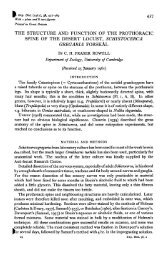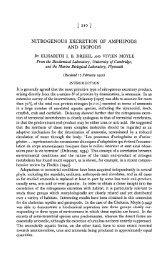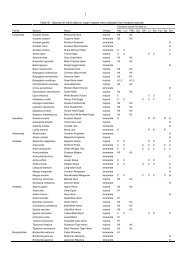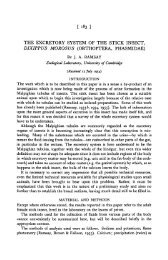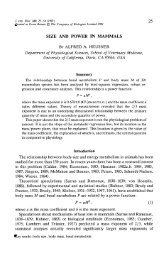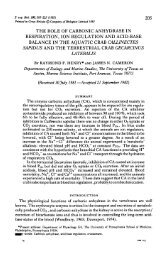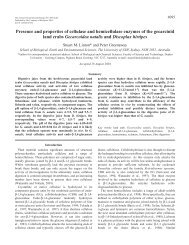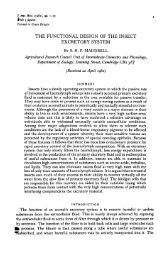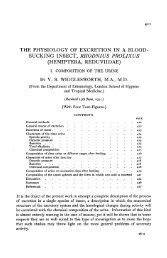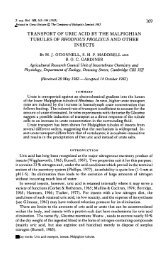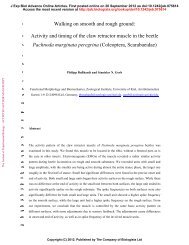Whistling in caterpillars (Amorpha juglandis, Bombycoidea): sound ...
Whistling in caterpillars (Amorpha juglandis, Bombycoidea): sound ...
Whistling in caterpillars (Amorpha juglandis, Bombycoidea): sound ...
You also want an ePaper? Increase the reach of your titles
YUMPU automatically turns print PDFs into web optimized ePapers that Google loves.
30<br />
The Journal of Experimental Biology 214, 30-37<br />
© 2011. Published by The Company of Biologists Ltd<br />
doi:10.1242/jeb.046805<br />
INTRODUCTION<br />
Caterpillars are preyed upon heavily by a host of natural predators,<br />
<strong>in</strong>clud<strong>in</strong>g birds, wasps, shrews, mice, bats, snakes, frogs, lizards,<br />
ants, beetles and spiders (Holmes et al., 1979; Wagner, 2005; Kalka<br />
and Kalko, 2006). In response, they have developed a variety of<br />
anti-predator strategies, which have been studied extensively (e.g.<br />
Lederhouse, 1990; Bowers, 1993; Stamp and Wilkens, 1993). The<br />
primary defense of a caterpillar is to rema<strong>in</strong> unseen (Stamp and<br />
Wilkens, 1993; Wagner, 2005). Morphological adaptations for<br />
concealment <strong>in</strong>clude crypsis through colour match<strong>in</strong>g (e.g. Edmunds<br />
and Grayson, 1991; Canfield et al., 2009), counter-shad<strong>in</strong>g (e.g.<br />
Rowland et al., 2008) or camouflage (e.g. de Ruiter, 1952; Greene,<br />
1989), whereas behavioural modifications <strong>in</strong>clude rest<strong>in</strong>g on the<br />
underside of leaves, restrict<strong>in</strong>g forag<strong>in</strong>g times, remov<strong>in</strong>g evidence<br />
of their presence by cutt<strong>in</strong>g leaves (He<strong>in</strong>rich, 1979) or throw<strong>in</strong>g<br />
frass (Weiss, 2003).<br />
Once a caterpillar has been detected by a predator, however, other<br />
defenses are often employed. These ‘secondary’ defenses can be<br />
chemical, physical or behavioural, <strong>in</strong>clud<strong>in</strong>g the presentation of traits<br />
that mimic unpalatable or potentially dangerous animals. Chemical<br />
defenses can be systemic, or emitted through regurgitation (Grant,<br />
2006). In several cases, these are advertised visually through bright<br />
coloration. For example, the black and yellow stripes of <strong>caterpillars</strong><br />
of the monarch (Danaus plexippus) butterfly advertise their<br />
sequestration of cardenolides (Bowers, 1993; Nishida, 2002), and<br />
RESEARCH ARTICLE<br />
<strong>Whistl<strong>in</strong>g</strong> <strong>in</strong> <strong>caterpillars</strong> (<strong>Amorpha</strong> <strong>juglandis</strong>, <strong>Bombycoidea</strong>): <strong>sound</strong>-produc<strong>in</strong>g<br />
mechanism and function<br />
Veronica L. Bura1 , Vanya G. Rohwer2 , Paul R. Mart<strong>in</strong>2 and Jayne E. Yack1, *<br />
1 2 Department of Biology, Carleton University, Ottawa, ON, Canada, K1S 5B6 and Department of Biology, Queen’s University,<br />
K<strong>in</strong>gston, ON, Canada, K7L 3N6<br />
*Author for correspondence (jyack@connect.carleton.ca)<br />
Accepted 7 October 2010<br />
SUMMARY<br />
Caterpillar defenses have been researched extensively, and, although most studies focus on visually communicated signals, little<br />
is known about the role that <strong>sound</strong>s play <strong>in</strong> defense. We report on whistl<strong>in</strong>g, a novel form of <strong>sound</strong> production for <strong>caterpillars</strong> and<br />
rare for <strong>in</strong>sects <strong>in</strong> general. The North American walnut sph<strong>in</strong>x (<strong>Amorpha</strong> <strong>juglandis</strong>) produces whistle ‘tra<strong>in</strong>s’ rang<strong>in</strong>g from 44 to<br />
2060�ms <strong>in</strong> duration and compris<strong>in</strong>g one to eight whistles. Sounds were categorized <strong>in</strong>to three types: broadband, pure whistles<br />
and multi-harmonic plus broadband, with mean dom<strong>in</strong>ant frequencies at 15�kHz, 9�kHz and 22�kHz, respectively. The mechanism of<br />
<strong>sound</strong> production was determ<strong>in</strong>ed by selectively obstruct<strong>in</strong>g abdom<strong>in</strong>al spiracles, monitor<strong>in</strong>g air flow at different spiracles us<strong>in</strong>g<br />
a laser vibrometer and record<strong>in</strong>g body movements associated with <strong>sound</strong> production us<strong>in</strong>g high-speed video. Contractions of the<br />
anterior body segments always accompanied <strong>sound</strong> production, forc<strong>in</strong>g air through a pair of enlarged spiracles on the eighth<br />
abdom<strong>in</strong>al segment. We tested the hypothesis that <strong>sound</strong>s function <strong>in</strong> defense us<strong>in</strong>g simulated attacks with blunt forceps and<br />
natural attacks with an avian predator – the yellow warbler (Dendroica petechia). In simulated attacks, 94% of <strong>caterpillars</strong><br />
responded with whistle tra<strong>in</strong>s that were frequently accompanied by directed thrash<strong>in</strong>g but no obvious chemical defense. In<br />
predator trials, all birds readily attacked the caterpillar, elicit<strong>in</strong>g whistle tra<strong>in</strong>s each time. Birds responded to whistl<strong>in</strong>g by<br />
hesitat<strong>in</strong>g, jump<strong>in</strong>g back or div<strong>in</strong>g away from the <strong>sound</strong> source. We conclude that caterpillar whistles are defensive and propose<br />
that they function specifically as acoustic ‘eye spots’ to startle predators.<br />
Supplementary material available onl<strong>in</strong>e at http://jeb.biologists.org/cgi/content/full/214/1/30/DC1<br />
Key words: <strong>sound</strong> production, caterpillar, acoustic communication, defense, <strong>Amorpha</strong> <strong>juglandis</strong>, whistle, yellow warbler.<br />
THE JOURNAL OF EXPERIMENTAL BIOLOGY<br />
the colourful black, red and yellow spurge hawkmoth <strong>caterpillars</strong><br />
(Hyles euphorbiae) broadcast their retention of phorbol esters <strong>in</strong><br />
the gut (Hundsdoerfer et al., 2005). Physical defenses <strong>in</strong>clude sp<strong>in</strong>es<br />
and hairs, which can also be coupled with a chemical defense (Deml<br />
and Dettner, 2002; L<strong>in</strong>dstedt et al., 2008; Murphy et al., 2010), as<br />
well as thrash<strong>in</strong>g, bit<strong>in</strong>g and dropp<strong>in</strong>g (Wagner, 2005). These sp<strong>in</strong>es<br />
can be exaggerated by bright colouration <strong>in</strong> some species (e.g. many<br />
Saturniidae) (Deml and Dettner, 2002) and are considered<br />
aposematic (Speed and Ruxton, 2005). Bluff<strong>in</strong>g can <strong>in</strong>volve nonchemically<br />
defended <strong>caterpillars</strong> mimick<strong>in</strong>g the colours of defended<br />
species or resembl<strong>in</strong>g some other, more dangerous, animal. For<br />
example, some hawkmoth <strong>caterpillars</strong> possess elaborate eyespots<br />
on their anterior thoracic segments that can be enlarged by retract<strong>in</strong>g<br />
the head <strong>in</strong>to the thorax. This display is said to resemble the head<br />
of a bird, snake, lizard or small mammal (Morrell, 1969; Pittaway,<br />
1993; Miller et al., 2006; Janzen et al., 2010).<br />
The vast majority of studies on caterpillar defense mechanisms<br />
<strong>in</strong>volve communication with predators <strong>in</strong> the visual realm<br />
(Lederhouse, 1990; Pittaway, 1993). Less is understood about<br />
exploit<strong>in</strong>g other sensory modalities of predators, such as hear<strong>in</strong>g.<br />
Defensive <strong>sound</strong>s <strong>in</strong> <strong>in</strong>sects are widespread and have been well<br />
documented (Masters, 1979; Masters, 1980; Ew<strong>in</strong>g, 1989) but are<br />
primarily reported <strong>in</strong> adults that have hard bodies and multiple<br />
mechanisms for produc<strong>in</strong>g <strong>sound</strong>s. However, there is <strong>in</strong>creas<strong>in</strong>g<br />
evidence that defensive <strong>sound</strong>s and vibrations might also be
widespread <strong>in</strong> soft-bodied larvae of holometabolous <strong>in</strong>sects. In<br />
Lepidoptera, two recent studies (Brown et al., 2007; Bura et al., 2009)<br />
show that <strong>sound</strong>s made by the mandibles <strong>in</strong> silk-moth <strong>caterpillars</strong> are<br />
accompanied by chemical defenses, and these are thought to function<br />
as warn<strong>in</strong>g <strong>sound</strong>s. Other prelim<strong>in</strong>ary reports suggest that <strong>sound</strong><br />
production is widespread <strong>in</strong> the superfamily <strong>Bombycoidea</strong> (reviewed<br />
<strong>in</strong> Brown et al., 2007). However, at present, little experimental work<br />
has been performed to validate the occurrence, mechanisms and<br />
functions of <strong>sound</strong> production <strong>in</strong> <strong>caterpillars</strong>.<br />
In this study, we <strong>in</strong>troduce a novel form of <strong>sound</strong> production <strong>in</strong><br />
<strong>caterpillars</strong> – whistl<strong>in</strong>g. While most <strong>in</strong>sects and <strong>caterpillars</strong> that<br />
generate <strong>sound</strong> do so by rubb<strong>in</strong>g body parts together or aga<strong>in</strong>st a<br />
substrate, few generate <strong>sound</strong> through us<strong>in</strong>g air expulsion. The<br />
walnut sph<strong>in</strong>x <strong>Amorpha</strong> <strong>juglandis</strong> caterpillar is a cryptic species<br />
found throughout much of North America (Tuttle, 2007). Sounds<br />
produced by these <strong>caterpillars</strong> have been described <strong>in</strong> pass<strong>in</strong>g as<br />
‘…a note resembl<strong>in</strong>g the <strong>sound</strong> tcêp or tceep’ (Sanborn, 1868),<br />
‘whistles’, ‘hisses’ and ‘squeaks’ (Wagner, 2005; Tuttle, 2007).<br />
Previous observers speculated that these <strong>sound</strong>s are generated by<br />
the spiracles (Wagner, 2005), but this has not been tested. In this<br />
study, we characterize the <strong>sound</strong>s produced by walnut sph<strong>in</strong>x<br />
<strong>caterpillars</strong>, test the hypothesis that they are produced by the spiracles<br />
and ga<strong>in</strong> <strong>in</strong>sight <strong>in</strong>to their defensive function by perform<strong>in</strong>g<br />
experiments with simulated and natural-predator attacks.<br />
MATERIALS AND METHODS<br />
Animals<br />
Larvae of the walnut sph<strong>in</strong>x, <strong>Amorpha</strong> <strong>juglandis</strong> (J. E. Smith 1797),<br />
were reared from eggs obta<strong>in</strong>ed from moths captured at ultraviolet<br />
lights at the Queen’s University Biological Station (QUBS; Lake<br />
Op<strong>in</strong>icon, Ontario, Canada; 44°33��55.34��N, 76°19��26.59��W) <strong>in</strong><br />
July 2008 and August 2009. Larvae were reared on cutt<strong>in</strong>gs of hop<br />
hornbeam (Ostyra sp.), alder (Alnus sp.), walnut (Juglans sp.) or<br />
beech (Fagus sp.). All experiments were performed on late (fourth<br />
or fifth) <strong>in</strong>star larvae. Caterpillars of Paonias myops (J. E. Smith),<br />
used for comparative purposes, were reared from eggs of moths<br />
captured at QUBS on cutt<strong>in</strong>gs of cherry (Prunus sp.).<br />
Sound record<strong>in</strong>gs and analysis<br />
Sounds analyzed for spectral and temporal characteristics were<br />
recorded from 10 <strong>caterpillars</strong> us<strong>in</strong>g a Brüel & Kjær (B&K; Naerum,<br />
Denmark) 1/4�<strong>in</strong>� microphone type 4939 (grid on), amplified with a<br />
Brüel & Kjær Nexxus condition<strong>in</strong>g amplifier type 2690 and recorded<br />
to a Fostex FR-2 Field Memory Recorder (Gardena, CA, USA) at<br />
a sampl<strong>in</strong>g rate of 192�kHz. Record<strong>in</strong>gs were analyzed us<strong>in</strong>g<br />
RavenPro Bioacoustics Research Program 1.4 (Cornell Laboratory<br />
of Ornithology, Ithaca, NY, USA). Sound production was <strong>in</strong>duced<br />
by plac<strong>in</strong>g an <strong>in</strong>dividual on a cutt<strong>in</strong>g of a host plant and deliver<strong>in</strong>g<br />
an attack to the abdomen with blunt forceps (see ‘Attack trials’ for<br />
details). All record<strong>in</strong>gs were performed <strong>in</strong> an acoustic chamber<br />
(Eckel Industries, Cambridge, MA, USA).<br />
Temporal characteristics, <strong>in</strong>clud<strong>in</strong>g tra<strong>in</strong> duration, number of<br />
pulses <strong>in</strong> a tra<strong>in</strong>, <strong>in</strong>ter-pulse <strong>in</strong>terval, pulse duration and the element<br />
(waveform) repetition rate, were measured from the first three tra<strong>in</strong>s<br />
of ten <strong>in</strong>dividuals. A tra<strong>in</strong> was def<strong>in</strong>ed as a series of <strong>sound</strong> pulses<br />
follow<strong>in</strong>g an attack, until <strong>sound</strong> production ceased. A pulse is a<br />
group of un<strong>in</strong>terrupted waves, or elements. Mann–Whitney U tests<br />
were performed to compare the durations of the first and third tra<strong>in</strong>s<br />
of 10 <strong>in</strong>dividuals to determ<strong>in</strong>e whether sensitization occurred and<br />
to compare the repetition rate of waveforms <strong>in</strong> different <strong>sound</strong> types.<br />
Measured spectral characteristics <strong>in</strong>cluded the fundamental and<br />
dom<strong>in</strong>ant frequencies and number of harmonics at –40�dB. Power<br />
THE JOURNAL OF EXPERIMENTAL BIOLOGY<br />
Caterpillar defensive whistles<br />
31<br />
spectra and spectrograms were produced us<strong>in</strong>g a 1024-po<strong>in</strong>t Fast<br />
Fourier Transform (Hann w<strong>in</strong>dow, 50% overlap). As pulses differed<br />
<strong>in</strong> their spectral qualities, they were categorized as types 1–3 (see<br />
Results for details). In order to determ<strong>in</strong>e where different pulse types<br />
occurred with<strong>in</strong> a tra<strong>in</strong>, pulse tra<strong>in</strong>s of 11 animals were analyzed.<br />
Sound pressure levels (SPLs) were measured from 10 <strong>sound</strong> pulses<br />
from five <strong>caterpillars</strong> by record<strong>in</strong>g with a B&K 1/4�<strong>in</strong> microphone<br />
type 4939 (grid on), and measur<strong>in</strong>g voltages on a Tektronix THS720A<br />
oscilloscope. Cont<strong>in</strong>uous pure tones centered at 10 and 15�kHz were<br />
generated us<strong>in</strong>g a Tabor Electronics 50MS/s Waveform Generator<br />
(WW5061, Tel Hanan, Israel) and broadcast through a Pioneer ART-<br />
54F Ribbon tweeter (Pioneer Electronics, Long Beach, CA, USA).<br />
Sounds were recorded us<strong>in</strong>g the B&K microphone set up (described<br />
above), and voltages were adjusted until the output was equal to those<br />
emitted by the <strong>caterpillars</strong>. The dB SPL values were then read from<br />
a B&K <strong>sound</strong>-level meter type�2239 placed at the same location as<br />
the microphone. Relative amplitudes of pulses occurr<strong>in</strong>g throughout<br />
a tra<strong>in</strong> were assessed from pulse tra<strong>in</strong>s <strong>in</strong> 10 <strong>caterpillars</strong> us<strong>in</strong>g the<br />
B&K record<strong>in</strong>gs described above.<br />
Sound production mechanism<br />
We tested the hypothesis that <strong>sound</strong>s result from the expulsion of<br />
air through spiracles and identified the specific source of <strong>sound</strong><br />
production us<strong>in</strong>g high-speed videography, selected reversible<br />
occlusions and laser vibrometry.<br />
Experiments us<strong>in</strong>g high-speed video were performed to exam<strong>in</strong>e<br />
body movements associated with <strong>sound</strong> production <strong>in</strong> five<br />
<strong>caterpillars</strong>. A larva was placed on a wooden stick and <strong>in</strong>duced to<br />
signal. A Lightn<strong>in</strong>g RDT (High Speed Imag<strong>in</strong>g, Markham, ON,<br />
Canada) camera captured 500 frames per second us<strong>in</strong>g Xcitec<br />
MiDAS 2.0 software (Cambridge, MA, USA) on an A70 Toshiba<br />
Satellite (Tokyo, Japan) notebook computer. Sounds were recorded<br />
simultaneously us<strong>in</strong>g a B&K 1/4�<strong>in</strong>ch microphone (see above) and<br />
a MiDAS DA-123 Data Acquisition Module (Cambridge, MA,<br />
USA). The relationship between body movements and <strong>sound</strong><br />
production was analyzed us<strong>in</strong>g Xcitec MiDAS 2.0 software.<br />
Reversible spiracular occlusions were performed to determ<strong>in</strong>e<br />
whether spiracles were <strong>in</strong>volved <strong>in</strong> <strong>sound</strong> production and, if so,<br />
which ones. In the first occlusion experiment, five <strong>caterpillars</strong> that<br />
were tested and confirmed to produce <strong>sound</strong>s were anesthetized<br />
us<strong>in</strong>g carbon dioxide, and clear make-up latex (LR-1, Ben Nye<br />
Company, Los Angeles, CA, USA) was applied to all eight<br />
abdom<strong>in</strong>al spiracles us<strong>in</strong>g the provided application brush. The latex<br />
would turn from white to clear when it had dried, which typically<br />
took less than 3�m<strong>in</strong>. The larva was placed on its dorsal side once<br />
the latex had dried and tested for <strong>sound</strong> production 5�m<strong>in</strong> after it<br />
had righted itself to ensure that all <strong>caterpillars</strong> tested were at the<br />
same level of alertness. To elicit <strong>sound</strong> production, a p<strong>in</strong>ch was<br />
delivered to the abdomen, and the <strong>sound</strong> (or lack thereof) was<br />
recorded us<strong>in</strong>g a Sony ECM-MS908C microphone and Sony DCR-<br />
TRV19 camera (Tokyo, Japan). The latex was then gently removed<br />
from pairs of spiracles, and the caterpillar was re-tested for <strong>sound</strong><br />
production. In a second experiment, 10 <strong>in</strong>dividuals were tested as<br />
above, but only the suspected <strong>sound</strong>-produc<strong>in</strong>g spiracles were<br />
covered. An additional control experiment was conducted on five<br />
separate <strong>in</strong>dividuals us<strong>in</strong>g the exact procedure as above but, <strong>in</strong>stead,<br />
cover<strong>in</strong>g a non-<strong>sound</strong>-produc<strong>in</strong>g abdom<strong>in</strong>al spiracle.<br />
Laser Doppler vibrometry was used to test further the hypothesis<br />
that <strong>sound</strong> was com<strong>in</strong>g out of a specific pair of spiracles, as well<br />
as to provide a visual record of air movements associated with these<br />
spiracles. A caterpillar was placed on a wooden stick so that the<br />
spiracle of <strong>in</strong>terest or a control spiracle was positioned perpendicular
32<br />
V. L. Bura and others<br />
to a th<strong>in</strong> (2�mm) strip of lens paper (Ross Optical, Ladd Research<br />
Industries, Burl<strong>in</strong>gton, VT, USA) suspended across a wooden frame<br />
at a distance of 1�cm from the spiracle. The beam of a laser<br />
vibrometer (PDV-100 Polytec, Irv<strong>in</strong>e, CA, USA) was reflected off<br />
the tissue paper us<strong>in</strong>g a reflective disc. Signal<strong>in</strong>g was <strong>in</strong>duced, and<br />
vibrations created by the <strong>sound</strong>s (or lack thereof) detected by the<br />
laser (Velocity 22�mm/s; high-pass-filter off; low-pass-filter 20�kHz)<br />
were recorded to a Marantz data recorder (PMD 671, D&M<br />
Professional, Itasca, IL, USA) at a sampl<strong>in</strong>g rate of 44.1�kHz.<br />
Anatomy of spiracles<br />
The external anatomy of the abdom<strong>in</strong>al spiracles of A. <strong>juglandis</strong><br />
was exam<strong>in</strong>ed to assess size differences between <strong>sound</strong>- and non<strong>sound</strong>-produc<strong>in</strong>g<br />
spiracles. Spiracles of five preserved <strong>caterpillars</strong><br />
were photographed us<strong>in</strong>g an Olympus SZX12 (Olympus<br />
Corporation, Tokyo, Japan) light-microscope equipped with an<br />
AxioCam MRc5 (Carl Zeiss Micro Imag<strong>in</strong>g GmbH, Gött<strong>in</strong>gen,<br />
Germany) camera. Images were captured us<strong>in</strong>g AxioVision 4.6, and<br />
the length and width of spiracles were measured us<strong>in</strong>g ImageJ 1.42q<br />
(NIH, USA). Mean sizes of the <strong>sound</strong>-produc<strong>in</strong>g spiracle were<br />
compared with all others us<strong>in</strong>g an ANOVA, and post hoc analyses<br />
were conducted with a Tukey–Kramer honest significant difference<br />
test us<strong>in</strong>g JMP8 statistical software. For comparison, spiracles <strong>in</strong><br />
P. myops, a similarly sized but silent species from the same<br />
subfamily as A. <strong>juglandis</strong>, were exam<strong>in</strong>ed as outl<strong>in</strong>ed above.<br />
Attack trials<br />
Attack trials were performed to exam<strong>in</strong>e the relationship between<br />
attack, <strong>sound</strong> production and other defenses, and to assess the<br />
response of a predator to the <strong>sound</strong>s. Simulated attacks us<strong>in</strong>g forceps<br />
and natural attacks with an avian predator were conducted. All<br />
experiments were performed on <strong>caterpillars</strong> rest<strong>in</strong>g on a sprig of<br />
host-plant and videotaped us<strong>in</strong>g a Sony DCR-HC85 Handycam<br />
equipped with a Sony ECM-MS957 microphone. Analysis of the<br />
trials was performed us<strong>in</strong>g iMovie 7.1.4.<br />
Dur<strong>in</strong>g simulated attack trials, larvae were isolated on sprigs at<br />
least 30�m<strong>in</strong> before experimentation, and behaviours were recorded<br />
for 60�s before attack and 60�s follow<strong>in</strong>g the commencement of the<br />
first attack. Attacks with blunt forceps were conducted to simulate<br />
an attack by a bird or the bite of a predatory <strong>in</strong>sect (e.g. Bowers,<br />
2003; Grant, 2006). Ten trials were performed where the rest<strong>in</strong>g<br />
caterpillar was attacked once near the head or abdomen and then<br />
quickly released. To assess further how an animal responded to<br />
multiple attacks, eight additional trials were performed where<br />
attacks were repeated five times, with an <strong>in</strong>terval of ~5�s between<br />
successive attacks. Trials were analyzed for the number of animals<br />
that produced <strong>sound</strong>s when attacked, and comparisons<br />
(Mann–Whitney U) were made with respect to the number of pulses<br />
produced 60�s before, and 60�s follow<strong>in</strong>g, a one- or five-p<strong>in</strong>ch attack.<br />
Videos were also analyzed to document other defensive behaviours<br />
associated with <strong>sound</strong> production.<br />
Predator trials were conducted with three captive yellow warblers<br />
(Parulidae, Dendroica petechia) at Queen’s University <strong>in</strong> K<strong>in</strong>gston,<br />
Ontario, Canada. Yellow warblers are a likely predator of the walnut<br />
sph<strong>in</strong>x as this bird frequently eats <strong>caterpillars</strong> (Lowther et al., 1999),<br />
and overlaps <strong>in</strong> distribution with the walnut sph<strong>in</strong>x (American<br />
Ornithologists’ Union, 1998; Tuttle, 2007). All yellow warblers were<br />
housed <strong>in</strong> <strong>in</strong>dividual cages (45.7�cm�45.7�cm�91.4�cm) with access<br />
to food (Exact Ra<strong>in</strong>bow Canary/F<strong>in</strong>ch diet, Kaytee Products,<br />
Chilton, WI, USA) and water ad libitum. The birds were accustomed<br />
to search<strong>in</strong>g foliage <strong>in</strong> their cage for prey items and previously had<br />
been fed live <strong>caterpillars</strong> of various species. The birds were born<br />
THE JOURNAL OF EXPERIMENTAL BIOLOGY<br />
<strong>in</strong> the wild but were raised <strong>in</strong> captivity from ~7 days old. For each<br />
trial, a caterpillar was placed on a twig <strong>in</strong>side the enclosure of the<br />
bird amidst the other vegetation and close to at least one perch.<br />
Trials began when the experimenter had moved away from the cage<br />
(~2�m) and ended when the bird no longer showed an <strong>in</strong>terest <strong>in</strong> the<br />
caterpillar. One trial was conducted for each bird, and trials lasted<br />
6–16�m<strong>in</strong>. This work was approved by the Queen’s University<br />
Animal Care and Use Committee (protocols 100340 and 100168)<br />
on birds that were held <strong>in</strong> captivity under Canadian Wildlife Service<br />
permit CA0243. Trials were analyzed for the defensive behaviour<br />
of the <strong>caterpillars</strong> (<strong>in</strong>clud<strong>in</strong>g <strong>sound</strong> production), the number of times<br />
the birds attacked, the latency to the first attack from the beg<strong>in</strong>n<strong>in</strong>g<br />
of the trial, and the reactions of the birds to the <strong>sound</strong>s.<br />
RESULTS<br />
Walnut sph<strong>in</strong>x <strong>caterpillars</strong> consistently generated audible ‘whistles’<br />
when attacked (see supplementary Movie�1), and <strong>sound</strong>s were<br />
sometimes accompanied by other defensive behaviours (see below).<br />
Dur<strong>in</strong>g our rear<strong>in</strong>g and handl<strong>in</strong>g of the <strong>caterpillars</strong>, we noted no<br />
evidence of <strong>caterpillars</strong> respond<strong>in</strong>g acoustically to the presence of<br />
conspecifics, and <strong>sound</strong> production was not detected <strong>in</strong> early <strong>in</strong>stars<br />
(1–3).<br />
Sound characteristics<br />
Temporal characteristics were measured from the first three pulse<br />
tra<strong>in</strong>s from 10 animals. Tra<strong>in</strong>s ranged from 90 to 8764�ms (mean<br />
2626±2339�ms; median 1907�ms) <strong>in</strong> duration and conta<strong>in</strong>ed 1–8<br />
pulses (Fig.�1A) (n�30). With<strong>in</strong> a given trial, no significant<br />
differences were observed <strong>in</strong> the durations of the first and third tra<strong>in</strong>s<br />
(Mann–Whitney U, P�0.88). Pulse durations ranged between 44<br />
and 2060�ms (mean 440±272�ms; median 420�ms) (n�101), and the<br />
mean <strong>in</strong>ter-pulse <strong>in</strong>terval was 501±282�ms (n�72). Not all pulses<br />
were the same <strong>in</strong> their spectral characteristics, and therefore we<br />
divided them <strong>in</strong>to one of three categories (Fig.�1; see supplementary<br />
Movie�1 and supplementary Audio�1). Type�1 pulses (Fig.�1B) conta<strong>in</strong><br />
one or two multiharmonic series occurr<strong>in</strong>g near the beg<strong>in</strong>n<strong>in</strong>g or<br />
middle of the pulse, with 16–48 harmonics per series. Type 2 pulses<br />
(Fig.�1C) were more broadband than type1 pulses throughout the<br />
entire pulse, often (67%) hav<strong>in</strong>g a short whistle at the very beg<strong>in</strong>n<strong>in</strong>g<br />
or end of the pulse. Type�3 pulses (Fig.�1D) were characterized as<br />
pure whistles, with one or two harmonic series with two to five<br />
harmonics per series. There was a trend with respect to where each<br />
type occurred dur<strong>in</strong>g a tra<strong>in</strong>, with all type�1 pulses occurr<strong>in</strong>g <strong>in</strong> the<br />
first third of a tra<strong>in</strong>, whereas 42.6% and 68.9% of types 2 and 3<br />
occurred <strong>in</strong> the middle and f<strong>in</strong>al third of the tra<strong>in</strong>, respectively (n�34<br />
tra<strong>in</strong>s; N�11). Characteristics of the broadband, multi-harmonic and<br />
pure whistle <strong>sound</strong>s from the various pulse types are displayed <strong>in</strong><br />
Fig.�1B–D and Table�1. Waveforms differed between multiharmonic,<br />
pure whistles and broadband <strong>sound</strong>s, with pure whistles<br />
hav<strong>in</strong>g a significantly higher element-repetition rate than the other<br />
two <strong>sound</strong>s (P�0.0001; Mann–Whitney U). Multi-harmonic and<br />
more broadband <strong>sound</strong>s had more complex waveforms, with<br />
repetition rates that also differed significantly from one another<br />
(P�0.0001; Mann–Whitney U) (see Table�1).<br />
Sound pressure levels of 10 pulses selected at random from five<br />
animals ranged from 69 to 82�dB SPL at 5�cm. The relative amplitude<br />
of pulses <strong>in</strong> a typical tra<strong>in</strong> decl<strong>in</strong>ed from the beg<strong>in</strong>n<strong>in</strong>g to the end,<br />
with the first be<strong>in</strong>g 12.9�dB greater on average than the last (N�10).<br />
Sound production mechanism<br />
Initial <strong>in</strong>vestigations <strong>in</strong>to the mechanism of <strong>sound</strong> production<br />
<strong>in</strong>volved videotap<strong>in</strong>g body movements that accompanied <strong>sound</strong>
Frequency (kHz)<br />
Sound level (dB)<br />
A<br />
B C D<br />
80<br />
60<br />
40<br />
20<br />
0<br />
0<br />
–20<br />
–40<br />
2 ms 2 ms 2 ms<br />
20 ms 20 ms 20 ms<br />
10 50 90 10 50<br />
Frequency (kHz)<br />
90 10 50 90<br />
production. Sound production was always accompanied by<br />
contraction of the anterior body segments (thorax and first two<br />
abdom<strong>in</strong>al segments) (Fig.�2). The contraction lasted 404±193�ms<br />
and began 98±111�ms before the onset of the <strong>sound</strong> (N�5).<br />
Follow<strong>in</strong>g the contraction, it took 156±36�ms to return to full<br />
extension.<br />
Occlusion experiments were conducted to determ<strong>in</strong>e, first,<br />
whether spiracles were <strong>in</strong>volved <strong>in</strong> <strong>sound</strong> production and then to<br />
identify which spiracles were <strong>in</strong>volved. When all abdom<strong>in</strong>al<br />
spiracles were obstructed, <strong>sound</strong> production was elim<strong>in</strong>ated <strong>in</strong> 100%<br />
of <strong>caterpillars</strong>, but, when the spiracles were uncovered, <strong>sound</strong><br />
production resumed <strong>in</strong> 100% of the <strong>in</strong>dividuals (N�5). In a second<br />
experiment, we applied latex to only the A8 spiracles, and <strong>sound</strong><br />
production was elim<strong>in</strong>ated <strong>in</strong> all trials (N�10). Once the latex was<br />
removed, <strong>sound</strong> production returned <strong>in</strong> all trials. The ability to signal<br />
was never lost <strong>in</strong> animals where another set of spiracles had been<br />
blocked (A7, N�5).<br />
Laser record<strong>in</strong>gs (N�5) confirmed that <strong>sound</strong> is produced by the<br />
movement of air through the A8 spiracles (Fig.�3). In all five<br />
Table 1. Spectral and temporal characteristics of different <strong>sound</strong><br />
categories (mean ± s.d.)<br />
Multi-harmonic Broadband Whistle<br />
Dom<strong>in</strong>ant frequency (kHz) 22.1±7.4 15.3±2.4 9.5±3.1<br />
Fundamental frequency (kHz) 3.5±0.9 – 8.8±1.4<br />
Number of elements <strong>in</strong> 10�ms 33.4±10.0 7.2±2.2 88.5±14.9<br />
N 10 10 10<br />
2 s<br />
THE JOURNAL OF EXPERIMENTAL BIOLOGY<br />
Caterpillar defensive whistles<br />
33<br />
Fig.�1. <strong>Amorpha</strong> <strong>juglandis</strong> <strong>sound</strong>s recorded from fifth-<strong>in</strong>star<br />
larvae. (A)�Oscillogram of three pulse tra<strong>in</strong>s follow<strong>in</strong>g three<br />
consecutive attacks. Attack onset is marked with an arrow.<br />
(B–D) Oscillograms and correspond<strong>in</strong>g spectrograms of timeexpanded<br />
pulses from A, show<strong>in</strong>g pulse types�1 (B), 2 (C) and 3<br />
(D). Insets represent an expanded time-scale of the area<br />
represented by the black circle. Spectrograms and power<br />
spectra represent segments of the oscillogram marked by the<br />
black circle.<br />
<strong>in</strong>dividuals, the laser registered a large-amplitude signal when placed<br />
<strong>in</strong> front of A8 but not when placed <strong>in</strong> front of the control spiracle<br />
(A5). There was evidence of a small amount of vibration when<br />
record<strong>in</strong>g over A5 (Fig.�3), but this occurred regardless of whether<br />
that spiracle was exposed or covered with latex. Therefore, we<br />
conclude that these vibrations were be<strong>in</strong>g picked up <strong>in</strong>directly from<br />
<strong>sound</strong>s produced by A8.<br />
Spiracle anatomy<br />
External measurements of the spiracles <strong>in</strong> A. <strong>juglandis</strong> revealed that<br />
A8 was longer than the other seven abdom<strong>in</strong>al spiracles (A8 and<br />
A7, P�0.0007; A8 and all other spiracles P
34<br />
A<br />
B<br />
V. L. Bura and others<br />
0<br />
0.48<br />
0.65<br />
0.1 s<br />
Fig.�2. Body movements associated with <strong>sound</strong> production. (A)�High-speed<br />
video frames of a larva dur<strong>in</strong>g <strong>sound</strong> production show<strong>in</strong>g, from left to right,<br />
the beg<strong>in</strong>n<strong>in</strong>g of compression, full compression and full extension (scale<br />
bar, 2.5�mm). Times of occurrence for each frame are <strong>in</strong>dicated below each<br />
frame. (B)�Oscillogram of the associated <strong>sound</strong>, with arrows mark<strong>in</strong>g the<br />
occurrence of the frames <strong>in</strong> A.<br />
p<strong>in</strong>ch attack was not significant (P�0.3488; Mann–Whitney U).<br />
When attacks were directed to the posterior abdomen, the caterpillar<br />
would release its first whistle while thrash<strong>in</strong>g once towards the site<br />
of attack, presumably <strong>in</strong>tend<strong>in</strong>g to bite the attacker. The caterpillar<br />
would then return to its rest<strong>in</strong>g position and cont<strong>in</strong>ue its <strong>sound</strong> pulse<br />
tra<strong>in</strong> coupled with the telescop<strong>in</strong>g body movements. Anterior<br />
attacks elicited the same series of behaviours except that the<br />
caterpillar would flick its anterior body away from the p<strong>in</strong>ch <strong>in</strong>stead<br />
of towards it. Regurgitation was observed only once dur<strong>in</strong>g a onep<strong>in</strong>ch<br />
trial and was not observed <strong>in</strong> any of the five-p<strong>in</strong>ch trials or<br />
any of the multi-attack B&K trials conducted for <strong>sound</strong> record<strong>in</strong>gs.<br />
Trials with yellow warblers were performed to assess the<br />
behaviours of both the caterpillar and an avian predator. An attack<br />
event was def<strong>in</strong>ed as the bird peck<strong>in</strong>g at the caterpillar one or more<br />
times <strong>in</strong> a row follow<strong>in</strong>g an <strong>in</strong>spection. Each of the three birds<br />
attacked the caterpillar more than once (2.7±0.6 times; N�3), and<br />
each attack provoked the caterpillar to make <strong>sound</strong>s. Acoustic<br />
responses were similar to those <strong>in</strong> the simulated attacks, with tra<strong>in</strong><br />
durations of 2800±2250�ms, and 1–8 pulses per tra<strong>in</strong> (N�3; n�11).<br />
The larva never produced <strong>sound</strong> before the <strong>in</strong>itial attack <strong>in</strong> a trial.<br />
However, once each bird provoked the caterpillar to produce <strong>sound</strong><br />
by attack<strong>in</strong>g it, the caterpillar became sensitized and subsequent<br />
<strong>sound</strong> tra<strong>in</strong>s could be evoked simply by leaf movements produced<br />
by the approach<strong>in</strong>g bird. Thrash<strong>in</strong>g responses by the caterpillar were<br />
similar to those observed <strong>in</strong> forceps attacks, whereby attacks to the<br />
anterior caused the caterpillar to flick its head away from the bird,<br />
and posterior attacks caused the caterpillar to arc its head dorsally<br />
towards the site of attack. As far as we could determ<strong>in</strong>e, <strong>in</strong> each<br />
trial, there was no evidence of caterpillar regurgitation.<br />
Follow<strong>in</strong>g the onset of a trial, the average latency to the <strong>in</strong>itial<br />
attack by birds was 140±112�s. The birds responded to the first tra<strong>in</strong><br />
of <strong>sound</strong>s by fl<strong>in</strong>ch<strong>in</strong>g, cock<strong>in</strong>g their heads and <strong>in</strong>spect<strong>in</strong>g, and<br />
THE JOURNAL OF EXPERIMENTAL BIOLOGY<br />
A<br />
B<br />
Fig.�3. Spiracle anatomy and air expulsion. (A)�A fifth-<strong>in</strong>star caterpillar (scale<br />
bar, 5�mm) show<strong>in</strong>g the fifth and eighth abdom<strong>in</strong>al spiracles magnified <strong>in</strong><br />
the <strong>in</strong>set (<strong>in</strong>set scale bars, 0.25�mm). (B)�Oscillograms obta<strong>in</strong>ed from laser<br />
record<strong>in</strong>gs show<strong>in</strong>g the movement of air produced by a <strong>sound</strong> pulse when<br />
either positioned above the fifth (left) or eighth (right) spiracles.<br />
eventually mov<strong>in</strong>g away from the caterpillar by hopp<strong>in</strong>g or fly<strong>in</strong>g<br />
away. Each bird attempted a second attack 223±98�s after it had<br />
moved away from the caterpillar, and responded to the <strong>sound</strong>s of<br />
the caterpillar by aga<strong>in</strong> mov<strong>in</strong>g away. In one case, the response was<br />
dramatic, with the bird div<strong>in</strong>g down and away from the caterpillar<br />
<strong>in</strong>to thicker vegetation, as if attacked by a predator (Gaddis, 1980;<br />
Lima, 1993) (see Fig.�4 and supplementary Movie�2). In each case,<br />
the caterpillar rema<strong>in</strong>ed unmolested <strong>in</strong> the cage with the bird for an<br />
average of 8�m<strong>in</strong> 59�s ± 5�m<strong>in</strong> 49�s after the last attack, and trials<br />
were term<strong>in</strong>ated when the bird no longer showed an <strong>in</strong>terest <strong>in</strong> the<br />
caterpillar. Caterpillars <strong>in</strong>volved <strong>in</strong> our trials survived the attacks<br />
by yellow warblers and exhibited no obvious wounds from the<br />
attacks.<br />
In summary, dur<strong>in</strong>g all of the attack trials, <strong>sound</strong> production was<br />
the most consistent response to attack. Upon the first attack dur<strong>in</strong>g<br />
a trial, <strong>sound</strong> production was accompanied by directed thrash<strong>in</strong>g,<br />
but, upon subsequent attacks, <strong>sound</strong> production was not necessarily<br />
accompanied by thrash<strong>in</strong>g. Regurgitation was rare dur<strong>in</strong>g attack<br />
trials, occurr<strong>in</strong>g only <strong>in</strong> 3% (1/31) of all trials (1 of 18 forceps trials,<br />
none of three bird trials, and none of 10 multi-attack trials conducted<br />
for the B&K <strong>sound</strong> trials). However, we noted that, outside of formal<br />
attack trials, regurgitation was observed <strong>in</strong> situations when it was<br />
necessary to handle the <strong>caterpillars</strong> cont<strong>in</strong>ually for extended periods,<br />
such as when they were be<strong>in</strong>g set up for occlusion trials or when<br />
chang<strong>in</strong>g their food <strong>in</strong> their enclosures. Dur<strong>in</strong>g these times,<br />
<strong>caterpillars</strong> would regurgitate more readily and try to bite, but such<br />
behaviours, typically, were not accompanied by <strong>sound</strong> production.<br />
DISCUSSION<br />
Sound production and hear<strong>in</strong>g have evolved multiple times <strong>in</strong> adult<br />
Lepidoptera (moths and butterflies), and research on the topic has<br />
contributed to the fields of neuroethology, ecology and animal<br />
behaviour (Conner, 1999; M<strong>in</strong>et and Surlykke, 2003; Yack, 2004).<br />
However, comparatively little is known about the roles that <strong>sound</strong>s<br />
and vibrations play <strong>in</strong> larval Lepidoptera, although a grow<strong>in</strong>g body<br />
of literature suggests that acoustic communication is widespread<br />
(Tautz and Markl, 1978; Travassos and Pierce, 2000; Yack et al.,
A<br />
B<br />
Inspection (t=0 s)<br />
Attack (t=0.15 s)<br />
Dive (t=0.33 s)<br />
2001; Castellanos and Barbosa, 2006; Fletcher et al., 2006; Scott<br />
et al., 2010). Although naturalists have described the defensive<br />
<strong>sound</strong>s produced by silk and hawkmoth (<strong>Bombycoidea</strong>) <strong>caterpillars</strong><br />
(reviewed <strong>in</strong> Brown et al., 2007), the function and mechanism of<br />
<strong>sound</strong> production <strong>in</strong> these <strong>caterpillars</strong> rema<strong>in</strong> largely unknown. We<br />
describe a novel form of <strong>sound</strong> production – whistl<strong>in</strong>g – and discuss<br />
its possible function.<br />
Sound production mechanism<br />
Our results support the hypothesis that the <strong>sound</strong>s of walnut sph<strong>in</strong>x<br />
<strong>caterpillars</strong> are produced by air expulsion. Reports on this mode of<br />
<strong>sound</strong> production <strong>in</strong> <strong>in</strong>sects are extremely rare (Haskell, 1974;<br />
Ew<strong>in</strong>g, 1989), with few studied examples. The death’s-head<br />
hawkmoth, Acherontia atropos, produces a two-part cry by the<br />
movement of air <strong>in</strong> and out of the pharyngeal cavity (Busnel and<br />
Dumortier, 1959; Dumortier, 1963). The first part of the cry occurs<br />
as air moves through the proboscis and past the epipharynx, caus<strong>in</strong>g<br />
it to vibrate. The second part is caused when the epipharynx is raised<br />
and the air is forced out through the proboscis. Madagascar hiss<strong>in</strong>g<br />
cockroaches of the genera Gromphadorh<strong>in</strong>a and Elliptorh<strong>in</strong>a<br />
produce <strong>sound</strong>s by forc<strong>in</strong>g air through an area of modified trachea<br />
and a pair of specialized spiracles (Nelson, 1979; Sueur and Aub<strong>in</strong>,<br />
2006). In the walnut sph<strong>in</strong>x, we show that <strong>sound</strong>s are produced by<br />
air be<strong>in</strong>g forced out of the last abdom<strong>in</strong>al spiracle (A8). Occlusion<br />
of the A8 spiracles (but not other spiracles) elim<strong>in</strong>ates <strong>sound</strong><br />
production, and air movements are observed when tissue is placed<br />
over these spiracles. We propose that the <strong>sound</strong>-produc<strong>in</strong>g<br />
mechanism operates similarly to that reported for hiss<strong>in</strong>g<br />
cockroaches (Nelson, 1979). In the cockroach, hisses are generated<br />
when the animal closes all spiracles, except the enlarged fourth<br />
abdom<strong>in</strong>al spiracle, and forces air out the latter by contract<strong>in</strong>g the<br />
abdom<strong>in</strong>al expiratory muscles. In the walnut sph<strong>in</strong>x, we propose<br />
that <strong>sound</strong>s are produced by air be<strong>in</strong>g forced out of the enlarged<br />
A8 spiracles dur<strong>in</strong>g successive contractions of the anterior dorsoand<br />
ventro-longitud<strong>in</strong>al muscles, while all other spiracles are<br />
ma<strong>in</strong>ta<strong>in</strong>ed <strong>in</strong> a closed position. The variation <strong>in</strong> frequency structure<br />
observed between pulse types is probably related to blow<strong>in</strong>g<br />
pressure as chang<strong>in</strong>g forces have an effect on frequency properties<br />
of <strong>sound</strong>s (Bradbury and Vehrencamp, 1998). In the walnut sph<strong>in</strong>x,<br />
multiharmonic type�1 pulses, with their complex waveforms, occur<br />
near the beg<strong>in</strong>n<strong>in</strong>g of the pulse tra<strong>in</strong>s, where the force is greatest,<br />
whereas pure whistles occur at the end of tra<strong>in</strong>s, where the pulses<br />
Dive cont<strong>in</strong>ues (t=0.43 s)<br />
THE JOURNAL OF EXPERIMENTAL BIOLOGY<br />
Caterpillar defensive whistles<br />
0.05 s<br />
35<br />
Fig.�4. Reaction of a yellow warbler to<br />
the defensive <strong>sound</strong>s of the walnut<br />
sph<strong>in</strong>x caterpillar. (A)�Video frames of<br />
the encounter, with the time of<br />
occurrence appended <strong>in</strong> parentheses.<br />
The white arrow <strong>in</strong> frame 1 <strong>in</strong>dicates<br />
the position of the caterpillar.<br />
(B)�Oscillogram of the caterpillar<br />
<strong>sound</strong>s, with arrows correspond<strong>in</strong>g to<br />
the onset of each video frame shown<br />
<strong>in</strong> A. The <strong>sound</strong> pulse follow<strong>in</strong>g the<br />
fourth arrow is the noise produced by<br />
the retreat<strong>in</strong>g bird.<br />
are less <strong>in</strong>tense. The size of the spiracle open<strong>in</strong>g might also affect<br />
the frequency structure. Broadband hisses produced by cockroaches<br />
occur when the spiracle is completely open, whereas pure whistles<br />
occur when the spiracle is partially closed (Fraser and Nelson, 1982).<br />
Based on the resemblance of types 1 and 2 pulses to the hisses, and<br />
type�3 to the whistles, of cockroaches, a similar mechanism is<br />
possibly be<strong>in</strong>g employed. The specific mechanisms underly<strong>in</strong>g<br />
<strong>sound</strong> production <strong>in</strong> the walnut sph<strong>in</strong>x could be further explored<br />
us<strong>in</strong>g anatomical and neurophysiological studies of the respiratory<br />
system, as well as visualization of <strong>in</strong>ternal trachea dur<strong>in</strong>g <strong>sound</strong><br />
production us<strong>in</strong>g X-ray imag<strong>in</strong>g <strong>in</strong> live animals (Westneat et al.,<br />
2003).<br />
Function<br />
We conclude that <strong>sound</strong> production <strong>in</strong> the walnut sph<strong>in</strong>x functions<br />
<strong>in</strong> defense because an acoustic response is elicited consistently<br />
follow<strong>in</strong>g attack by an artificial or natural predator. Defense <strong>sound</strong>s<br />
are commonly reported <strong>in</strong> <strong>in</strong>sects (Masters, 1979) and are<br />
hypothesized to serve a variety of different functions, <strong>in</strong>clud<strong>in</strong>g<br />
startle [e.g. peacock butterfly (Mohl and Miller, 1976); tiger beetles<br />
(Yager and Spangler, 1997)], warn<strong>in</strong>g or aposematism [e.g.<br />
stridulation <strong>in</strong> many <strong>in</strong>sects (Masters, 1979); hiss<strong>in</strong>g <strong>in</strong> bumblebees<br />
(Kirchner and Röschard, 1999)], mimicry [e.g. Batesian, drone flies,<br />
hoverflies and Hymenoptera (Brower and Brower, 1965; Rashed et<br />
al., 2009); Mullerian, tiger moths (Barber and Conner, 2007)],<br />
jamm<strong>in</strong>g [e.g. tiger moths (Conner, 1999; Corcoran et al., 2009)]<br />
and recruitment of conspecifics [e.g. hiss<strong>in</strong>g <strong>in</strong> honey bees (Sen<br />
Sarma et al., 2002)]. In the follow<strong>in</strong>g discussion, we argue <strong>in</strong> favour<br />
of the hypothesis that <strong>sound</strong>s made by walnut sph<strong>in</strong>x <strong>caterpillars</strong><br />
function to startle vertebrate predators.<br />
Before further discuss<strong>in</strong>g the function of defensive <strong>sound</strong>s, it is<br />
important to consider which predators the signals are directed<br />
towards. To the best of our knowledge, there are no reports<br />
describ<strong>in</strong>g the predators of walnut sph<strong>in</strong>x <strong>caterpillars</strong>. However, we<br />
assume that they are consumed by the same predators as those of<br />
other hawkmoth <strong>caterpillars</strong>, <strong>in</strong>clud<strong>in</strong>g birds as a major predator,<br />
as well as bats, mice, shrews, wasps, ants, beetles and spiders<br />
(Pittaway, 1993; Tuttle, 2007). The whistles produced by A.<br />
<strong>juglandis</strong> overlap with the frequency range of hear<strong>in</strong>g <strong>in</strong> most birds<br />
(Dool<strong>in</strong>g, 1991), and our results show that yellow warblers, a likely<br />
predator of the walnut sph<strong>in</strong>x, react to the caterpillar <strong>sound</strong>s.<br />
Caterpillar whistles also have significant energy <strong>in</strong> the ultra<strong>sound</strong>
36<br />
V. L. Bura and others<br />
range and, thus, could be directed at glean<strong>in</strong>g bats and mice. There<br />
is evidence that bats eat large <strong>caterpillars</strong> (Kalka and Kalko, 2006;<br />
Wilson and Barclay, 2006), and mice are repelled by <strong>sound</strong>s<br />
produced by <strong>in</strong>sects with similar <strong>sound</strong> frequencies [e.g. bee hiss<strong>in</strong>g<br />
(Kirchner and Röschard, 1999)]. Common arthropod predators that<br />
attack <strong>caterpillars</strong>, <strong>in</strong>clud<strong>in</strong>g wasps, ants, carabid and cocc<strong>in</strong>ellid<br />
beetles, bugs and spiders (Stamp and Wilkens, 1993), lack tympanal<br />
ears (Yack, 2004), and we therefore conclude that the defensive<br />
<strong>sound</strong>s of <strong>caterpillars</strong> target primarily vertebrate predators.<br />
We propose that defensive whistles function to startle predators<br />
and thereby reduce the risk of predation. Startle displays typically<br />
have three features (Edmunds, 1974; Sargent, 1990; Ruxton et al.,<br />
2004). First, they are employed by the prey only after be<strong>in</strong>g<br />
disturbed. In support of this, walnut sph<strong>in</strong>x <strong>caterpillars</strong> whistled only<br />
after be<strong>in</strong>g attacked, rely<strong>in</strong>g on crypsis as a primary defense. Second,<br />
the display is conspicuous, caus<strong>in</strong>g the predator to hesitate<br />
momentarily while the prey has an opportunity to escape. The<br />
<strong>in</strong>timidat<strong>in</strong>g nature of the <strong>sound</strong>s produced by walnut sph<strong>in</strong>x was<br />
evident from the reaction of the yellow warblers. The <strong>sound</strong>s were<br />
loud (i.e. conspicuous) and caused the birds to hesitate or abandon<br />
their attacks on the caterpillar. In one case, the bird dived away<br />
from the caterpillar <strong>in</strong>to thicker vegetation <strong>in</strong> a manner similar to<br />
how it would react to a predator (Gaddis, 1980; Lima, 1993).<br />
Contrary to what is predicted for startle <strong>sound</strong>s, however, none of<br />
the <strong>caterpillars</strong> attempted to escape. This could be expla<strong>in</strong>ed by the<br />
fact that escape is not a viable option for large <strong>caterpillars</strong>. They<br />
cannot run or fly away, and, although dropp<strong>in</strong>g from the leaf on<br />
silk is a common defense strategy for some <strong>caterpillars</strong>, this has not<br />
been observed <strong>in</strong> the <strong>Bombycoidea</strong> (Sugiura and Yamazaki, 2006).<br />
Presumably, large <strong>caterpillars</strong> do not drop on silk strands because<br />
a silk strand cannot support their weight, and dropp<strong>in</strong>g to the ground<br />
is both energetically costly and dangerous (Dethier, 1959). F<strong>in</strong>ally,<br />
the prey is not otherwise defended, and therefore predators will<br />
habituate to the signals.<br />
Dur<strong>in</strong>g attack trials with forceps or birds, regurgitation was<br />
extremely rare – dur<strong>in</strong>g all 31 trials (<strong>in</strong>clud<strong>in</strong>g 18 formal attack<br />
trials with forceps, 10 forceps attacks dur<strong>in</strong>g the B&K trials and<br />
three bird trials), a caterpillar regurgitated only once (3.2%). Grant<br />
(Grant, 2006) categorizes <strong>caterpillars</strong> accord<strong>in</strong>g to how much they<br />
regurgitate <strong>in</strong> response to attacks with forceps: primary regurgitators<br />
regurgitate soon after attack (1–3 p<strong>in</strong>ches), can control the amount<br />
released and the direction it is aimed and re-imbibe the bubble when<br />
attacks cease. Secondary regurgitators (4–6 p<strong>in</strong>ches) will regurgitate<br />
after thrash<strong>in</strong>g, bit<strong>in</strong>g or try<strong>in</strong>g to escape, cannot control the amount<br />
released and do not re-imbibe. F<strong>in</strong>ally, non-regurgitators will<br />
regurgitate only after long-last<strong>in</strong>g attacks (8–10 p<strong>in</strong>ches, if at all),<br />
and this might be a result of exhaustion or stress rather than a true<br />
defense. Accord<strong>in</strong>g to this classification scheme, the walnut sph<strong>in</strong>x<br />
would be classified as a non-regurgitator. This is <strong>in</strong> contrast to<br />
previous studies of <strong>sound</strong> production <strong>in</strong> <strong>caterpillars</strong>, where <strong>sound</strong><br />
is strongly correlated with the occurrence of a chemical defense and<br />
believed to be aposematic (Brown et al., 2007; Bura et al., 2009).<br />
In the absence of a chemical or physical defense, it is argued<br />
that attackers will become habituated to the signals and eventually<br />
eat the caterpillar. However, the yellow warblers <strong>in</strong> this study were<br />
clearly deterred by the <strong>sound</strong>s and did not habituate dur<strong>in</strong>g the<br />
course of the trial sufficiently to return and eat the caterpillar.<br />
Although certa<strong>in</strong> predators might become habituated to startle<br />
displays <strong>in</strong> experimental studies, the type of predator and the<br />
frequency of encounter<strong>in</strong>g the display will dictate how the predator<br />
responds (e.g. Bates and Fenton, 1990; Vall<strong>in</strong> et al., 2005; Vall<strong>in</strong><br />
et al., 2007). In nature, yellow warblers are active foragers,<br />
THE JOURNAL OF EXPERIMENTAL BIOLOGY<br />
constantly mov<strong>in</strong>g through vegetation <strong>in</strong> their territories <strong>in</strong> search<br />
of food [average territory size across their breed<strong>in</strong>g range varied<br />
from 0.04 to 0.39�ha (Lowther et al., 1999)]. Thus, if a warbler is<br />
deterred from eat<strong>in</strong>g a caterpillar dur<strong>in</strong>g an attack, the same bird<br />
is unlikely to encounter the caterpillar aga<strong>in</strong> soon afterwards. In<br />
addition, forag<strong>in</strong>g time is frequently limited for birds, and they<br />
must weigh the costs and benefits of potentially dangerous prey<br />
while be<strong>in</strong>g vigilant for predators themselves (Kaby and L<strong>in</strong>d,<br />
2003). Thus, we suggest that, if forag<strong>in</strong>g yellow warblers<br />
encountered prey that produce a startl<strong>in</strong>g <strong>sound</strong> <strong>in</strong> the wild, these<br />
birds would move on to other food rather than risk a prolonged<br />
attack on a potentially dangerous food item. A similar argument<br />
has been used recently to expla<strong>in</strong> the efficacy of eye-spot displays<br />
<strong>in</strong> tropical <strong>caterpillars</strong> (Janzen et al., 2010).<br />
In conclusion, <strong>caterpillars</strong> of the walnut sph<strong>in</strong>x produce whistles<br />
by forc<strong>in</strong>g air through the eighth abdom<strong>in</strong>al spiracles. We<br />
hypothesize that <strong>caterpillars</strong> have specific control over <strong>in</strong>dividual<br />
spiracles such that all but the eighth pair are closed dur<strong>in</strong>g body<br />
contractions. Further studies on the respiratory system will lend<br />
<strong>in</strong>sights <strong>in</strong>to the specific modifications to the nervous, tracheal and<br />
musculature systems that have accompanied the evolution of <strong>sound</strong><br />
production. We conclude that whistles function as part of the<br />
defensive repertoire of the larvae and propose, based on our results<br />
to date, that these <strong>sound</strong>s protect the caterpillar by startl<strong>in</strong>g predators.<br />
This hypothesis could be further tested with predator trials on muted<br />
<strong>caterpillars</strong> to determ<strong>in</strong>e whether <strong>sound</strong> alone is sufficient to deter<br />
predation, or with predator trials on undefended and palatable food<br />
items while broadcast<strong>in</strong>g walnut sph<strong>in</strong>x <strong>sound</strong>s. Future studies with<br />
natural predators of different species, <strong>in</strong>clud<strong>in</strong>g arthropods, will help<br />
to clarify the specific role, or roles, that whistl<strong>in</strong>g plays <strong>in</strong> the<br />
survival of these <strong>caterpillars</strong>.<br />
ACKNOWLEDGEMENTS<br />
We thank Queen’s University Biology Station for permission to use the facilities,<br />
Jenn Mongra<strong>in</strong> and Matt Jackson for collect<strong>in</strong>g of wild specimens, and Alan<br />
Flem<strong>in</strong>g for technical assistance. We are grateful to Jerome Sueur and an<br />
anonymous reviewer for helpful comments. Fund<strong>in</strong>g was provided by the Natural<br />
Sciences and Eng<strong>in</strong>eer<strong>in</strong>g Research Council of Canada (CGS M to V.L.B. and<br />
Discovery Grants to J.E.Y. and P.R.M.), the Canadian Foundation for Innovation,<br />
the Ontario Innovation Trust (J.E.Y.) and David and Rachel Epste<strong>in</strong> Foundation<br />
(V.L.B.).<br />
REFERENCES<br />
American Ornithologists’ Union (1998). Check-list of North American Birds, 7th edn.<br />
Wash<strong>in</strong>gton DC: American Ornithologists’ Union.<br />
Barber, J. R. and Conner, W. E. (2007). Acoustic mimicry <strong>in</strong> a predator-prey<br />
<strong>in</strong>teraction. Proc. Natl. Acad. Sci. USA 104, 9331-9334.<br />
Bates, D. L. and Fenton, M. B. (1990). Aposematism or startle? Predators learn their<br />
responses to the defenses of prey. Can. J. Zool. 68, 49-52.<br />
Bowers, M. D. (1993). Aposematic <strong>caterpillars</strong>: life-styles of the warn<strong>in</strong>gly colored and<br />
unpalatable. In Caterpillars: Ecological and Evolutionary Contra<strong>in</strong>ts on Forag<strong>in</strong>g (ed.<br />
N. E. Stamp and T. M. Casey), pp. 331-371. New York: Routledge, Chapman and<br />
Hall, <strong>in</strong>corporated.<br />
Bowers, M. D. (2003). Hostplant suitability and defensive chemistry of the Catalpa<br />
sph<strong>in</strong>x, Ceratomia catalpae. J. Chem. Ecol. 29, 2359-2367.<br />
Bradbury, J. W. and Vehrencamp, S. L. (1998). Pr<strong>in</strong>ciples of Animal Communication.<br />
Massachusetts, USA: S<strong>in</strong>auer Associates, <strong>in</strong>corporated.<br />
Brower, J. Z. and Brower, L. P. (1965). Experimental studies of mimicry. 8. Further<br />
<strong>in</strong>vestigations of honeybees (Apis mellifera) and their dronefly mimics (Eristalis spp.).<br />
Am. Nat. 99, 173-187.<br />
Brown, S. G., Boettner, G. H. and Yack, J. E. (2007). Click<strong>in</strong>g <strong>caterpillars</strong>: acoustic<br />
aposematism <strong>in</strong> Antheraea polyphemus and other <strong>Bombycoidea</strong>. J. Exp. Biol. 210,<br />
993-1005.<br />
Bura, V. L., Flem<strong>in</strong>g, A. J. and Yack, J. E. (2009). What’s the buzz? Ultrasonic and<br />
sonic warn<strong>in</strong>g signals <strong>in</strong> <strong>caterpillars</strong> of the great peacock moth (Saturnia pyri).<br />
Naturwissenschaften 96, 713-718.<br />
Busnel, R. G. and Dumortier, B. (1959). Vérification par des methods d’analyse<br />
acoustique des hypotheses sur l’orig<strong>in</strong>e du cri du sph<strong>in</strong>x Acherontia atropos (L<strong>in</strong>né).<br />
B. Soc. Entomol. Fr. 64, 44-58.<br />
Canfield, M. R., Chang, S. and Pierce, N. E. (2009). The double cloak of <strong>in</strong>visibility:<br />
phenotypic plasticity and larval decoration <strong>in</strong> a geometrid moth, Synchlora frondaria,<br />
across three diet treatments. Ecol. Entomol. 34, 412-414.<br />
Castellanos, I. and Barbosa, P. (2006). Evaluation of predation risk by a caterpillar<br />
us<strong>in</strong>g substrate-borne vibrations. Anim. Behav. 72, 461-469.
Conner, W. E. (1999). ‘Un chant d’appel amoureux’: acoustic communication <strong>in</strong> moths.<br />
J. Exp. Biol. 202, 1711-1723.<br />
Corcoran, A. J., Barber, J. E. and Conner, W. E. (2009). Tiger moth jams bat sonar.<br />
Science 325, 325-327.<br />
Deml, R. and Dettner, K. (2002). Morphology and classification of larval scoli of<br />
Saturni<strong>in</strong>ae and Hemileuc<strong>in</strong>ae (Lepidoptera: Saturniidae). J. Zool. Syst. Evol.<br />
Research. 40, 82-91.<br />
De Ruiter, L. (1952). Some experiments on the camouflage of stick <strong>caterpillars</strong>.<br />
Behaviour 4, 222-232.<br />
Dethier, V. G. (1959). Food-plant distribution and density and larval dispersal as<br />
factors affect<strong>in</strong>g <strong>in</strong>sect populations. Can. Entomol. 92, 581-596.<br />
Dool<strong>in</strong>g, R. J. (1991). Hear<strong>in</strong>g <strong>in</strong> birds. In The Evolutionary Biology of Hear<strong>in</strong>g (ed. D.<br />
Webster, R. Fay and A. Popper), pp. 545-560. New York: Spr<strong>in</strong>ger-Verlag.<br />
Dumortier, B. (1963). Morphology of <strong>sound</strong> emission apparatus <strong>in</strong> Arthropoda. In<br />
Acoustic Behavior of Animals (ed. R. G. Busnel), pp. 277-338. New York: Elsevier.<br />
Edmunds, M. (1974). Defence <strong>in</strong> Animals: a Survey of Anti-predator Defences. New<br />
York: Logman Group Ltd.<br />
Edmunds, M. and Grayson, J. (1991). Camouflage and selective predation <strong>in</strong><br />
<strong>caterpillars</strong> of the poplar and eyed hawkmoths (Laothoe populi and Smer<strong>in</strong>thus<br />
ocellata). Biol. J. L<strong>in</strong>n. Soc. 42, 467-480.<br />
Ew<strong>in</strong>g, A. M. (1989). Arthropod Bioacoustics: Neurobiology and Behavior. New York:<br />
Cornell University Press.<br />
Fletcher, L. E., Yack, J. E., Fitzgerald, T. D. and Hoy, R. R. (2006). Vibrational<br />
communication <strong>in</strong> the cherry leaf roller caterpillar Caloptilia serot<strong>in</strong>ella<br />
(Gracillarioidea: Gracillariidae). J. Insect. Behav. 19, 1-18.<br />
Fraser, J. and Nelson, M. C. (1982). Frequency modulated courtship song <strong>in</strong> a<br />
cockroach. Anim. Behav. 30, 627-628.<br />
Gaddis, P. (1980). Mixed flocks, Accipiters, and antipredator behavior. Condor 82,<br />
348-349.<br />
Grant, J. (2006). Diversification of gut morphology <strong>in</strong> <strong>caterpillars</strong> is associated with<br />
defensive behavior. J. Exp. Biol. 209, 3018-3024.<br />
Greene, E. (1989). A diet-<strong>in</strong>duced developmental polymorphism <strong>in</strong> a caterpillar.<br />
Science 243, 643-646.<br />
Haskell, P. T. (1974). Sound Production. In The Physiology of Insecta, Second Edn<br />
(ed. M. Rockste<strong>in</strong>), pp. 353-410. New York: Academic Press.<br />
He<strong>in</strong>rich, B. (1979). Forag<strong>in</strong>g strategies of <strong>caterpillars</strong> – Leaf damage and possible<br />
predator avoidance strategies. Oecologia 42, 325-337.<br />
Holmes, R. T., Schultz, J. C. and Nothnagle, P. (1979). Bird predation on forest<br />
<strong>in</strong>sects: An exclosure experiment. Science 206, 462-463.<br />
Hundsdoerfer, A. K., Tshibangu, J. N., Wetterauer, B. and W<strong>in</strong>k, M. (2005).<br />
Sequestration of phorbol esters by aposematic larvae of Hyles euphorbiae<br />
(Lepidoptera: Sph<strong>in</strong>gidae)? Chemoecology 15, 261-267.<br />
Janzen, D. H., Hallwachs, W. and Burns, J. M. (2010). A tropical horde of counterfeit<br />
predator eyes. Proc. Natl. Acad. Sci. USA 26, 11659-11665.<br />
Kaby, U. and L<strong>in</strong>d, J. (2003). What limits predator detection <strong>in</strong> blue tits (Parus<br />
caeruleus): posture, task or orientation? Behav. Ecol. Sociobiol. 54, 534-538.<br />
Kalka, M. and Kalko, E. K. V. (2006). Glean<strong>in</strong>g bats as underestimated predators of<br />
herbivorous <strong>in</strong>sects: diet of Micronycteris microtis (Phyllostomidae) <strong>in</strong> Panama. J.<br />
Trop. Ecol. 22, 1-10.<br />
Kirchner, W. H. and Röschard, J. (1999). Hiss<strong>in</strong>g <strong>in</strong> bumblebees: an <strong>in</strong>terspecific<br />
defence signal. Insectes Soc. 46, 239-243.<br />
Lederhouse, R. C. (1990). Avoid<strong>in</strong>g the hunt: primary defenses of Lepidopteran<br />
<strong>caterpillars</strong>. In Insect Defenses: Adaptive Mechanisms and Strategies of Prey and<br />
Predators (ed. D. L. Evans and J. O. Schmidt), pp. 175-190. New York: State<br />
University of New York Press.<br />
Lima, S. L. (1993). Ecological and evolutionary perspectives on escape from predatory<br />
attach: a survey of North American birds. Wilson Bull. 105, 1-47.<br />
L<strong>in</strong>dstedt, C., L<strong>in</strong>dström, L. and Mappes, J. (2008). Hair<strong>in</strong>ess and warn<strong>in</strong>g colours<br />
as components of antipredator defence: additive or <strong>in</strong>teractive benefits? Anim.<br />
Behav. 75, 1703-1713.<br />
Lowther, P. E., Celada, C., Kle<strong>in</strong>, N. K., Rimmer, C. C. and Spector, D. A. (1999).<br />
Yellow Warbler (Dendroica petechia). In The Birds of North America Onl<strong>in</strong>e (ed. A.<br />
Poole). Ithaca: Cornell Lab of Ornithology.<br />
Masters, W. M. (1979). Insect disturbance stridulation: its defensive role. Behav. Ecol.<br />
Sociobiol. 5, 187-200.<br />
Masters, W. M. (1980). Insect disturbance stridulation: characterization of airborne and<br />
vibrational components of the <strong>sound</strong>. J. Comp. Physiol. A 135, 259-268.<br />
Miller, J. C., Janzen, D. H. and Hallwachs, W. (2006). 100 Caterpillars: Portraits from<br />
the Tropical Forests of Costa Rica. Cambridge: The Belknap Press of Harvard<br />
University Press.<br />
M<strong>in</strong>et, J. and Surlykke, A. (2003). Auditory and <strong>sound</strong> produc<strong>in</strong>g organs. In<br />
Handbook of Zoology, Vol. IV (Arthropoda: Insects. Lepidoptera, Moths and<br />
Butterflies, Vol. 2) (ed. N. P. Kristensen), pp. 289-323. New York: W. G. de Gruyter.<br />
THE JOURNAL OF EXPERIMENTAL BIOLOGY<br />
Caterpillar defensive whistles<br />
37<br />
Mohl, B. and Miller, L. A. (1976). Ultrasonic clicks produced by the peacock butterfly:<br />
a possible bat-repellent mechanism. J. Exp. Biol. 64, 639-644.<br />
Morrell, R. (1969). Play snake for safety. Animals 12, 154-155.<br />
Murphy, S. M., Leahy, S. M., Williams, L. S. and Lill, J. T. (2010). St<strong>in</strong>g<strong>in</strong>g sp<strong>in</strong>es<br />
protect slug <strong>caterpillars</strong> (Limacodidae) from multiple generalist predators. Behav.<br />
Ecol. 21, 153-160.<br />
Nelson, M. C. (1979). Sound production <strong>in</strong> the cockroach, Gromphadorh<strong>in</strong>a<br />
portentosa: the <strong>sound</strong>-produc<strong>in</strong>g apparatus. J. Comp. Physiol. 132, 27-38.<br />
Nishida, R. (2002). Sequestration of defensive substances from plants by Lepidoptera.<br />
Annu. Rev. Entomol. 47, 57-92.<br />
Pittaway, A. R. (1993). Hawkmoths of the Western Palaearctic. England: Harley<br />
Books.<br />
Rashed, A., Khan, M. I., Dawson, J. W., Yack, J. E. and Sherratt, T. N. (2009). Do<br />
hoverflies (Diptera: Syrphidae) <strong>sound</strong> like the Hymenoptera they morphologically<br />
resemble? Behav. Ecol. 20, 396-402.<br />
Rowland, H. M., Cuthill, I. C., Harvey, I. F., Speed, M. P. and Ruxton, G. D. (2008).<br />
Can’t tell the <strong>caterpillars</strong> from the trees: countershad<strong>in</strong>g enhances survival <strong>in</strong> a<br />
woodland. Proc. R. Soc. Lond. B Biol. Sci. 275, 2539-2545.<br />
Ruxton, G. D., Sherratt, T. N. and Speed, M. P. (2004). Avoid<strong>in</strong>g Attack: The<br />
Evolutionary Ecology of Crypsis, Warn<strong>in</strong>g Signals and Mimicry. New York: Oxford<br />
University Press.<br />
Sanborn, F. G. (1868). Musical larvae. Can. Entomol. 1, 48.<br />
Sargent, T. D. (1990). Startle as an anti-predator mechanism, with special reference to<br />
the underw<strong>in</strong>g moths, (Catocala). In Insect Defenses: Adaptive Mechanisms and<br />
Strategies of Prey and Predators (ed. D. L. Evans and J. O. Schmidt), pp. 229-250.<br />
Albany: State University of New York Press.<br />
Scott, J. L., Kawahara, A. K., Skev<strong>in</strong>gton, J. H., Yen, S. H., Sami, A., Smith, M. L.<br />
and Yack, J. E. (2010). The evolutionary orig<strong>in</strong>s of ritualized acoustic signals <strong>in</strong><br />
<strong>caterpillars</strong>. Nat. Commun. 1, article 4.<br />
Sen Sarma, M., Fuchs, S., Weber, C. and Tautz, J. (2002). Worker pip<strong>in</strong>g triggers<br />
hiss<strong>in</strong>g for coord<strong>in</strong>ated colony defence <strong>in</strong> the dwarf honeybee Apis florea. Zoology<br />
105, 215-223.<br />
Speed, M. P. and Ruxton, G. D. (2005). Aposematism: what should our start<strong>in</strong>g po<strong>in</strong>t<br />
be? Proc. R. Soc. Lond. B Biol. Sci. 272, 431-438.<br />
Stamp, N. E. and Wilkens, R. T. (1993). On the cryptic side of life: be<strong>in</strong>g unapparent<br />
to enemies and the consequences for forag<strong>in</strong>g and growth of <strong>caterpillars</strong>. In<br />
Caterpillars: Ecological and Evolutionary Contra<strong>in</strong>ts on Forag<strong>in</strong>g (ed. N. E. Stamp<br />
and T. M. Casey), pp. 283-330. New York: Routledge, Chapman and Hall,<br />
<strong>in</strong>corporated.<br />
Sueur, J. and Aub<strong>in</strong>, T. (2006). When males whistle at females: complex FM acoustic<br />
signals <strong>in</strong> cockroaches. Naturwissenschaften 93, 500-505.<br />
Sugiura, S. and Yamazaki, K. (2006). The role of silk threads as lifel<strong>in</strong>es for<br />
<strong>caterpillars</strong>: pattern and significance of lifel<strong>in</strong>e-climb<strong>in</strong>g behavior. Ecol. Entomol. 31,<br />
52-57.<br />
Tautz, J. and Markl, H. (1978). Caterpillars detect fly<strong>in</strong>g wasps by hairs sensitive to<br />
airborne vibration. Behav. Ecol. Sociobiol. 4, 101-110.<br />
Travassos, M. A. and Pierce, N. E. (2000). Acoustics, context and function of<br />
vibrational signal<strong>in</strong>g <strong>in</strong> a lycaenid butterfly-ant mutualism. Anim. Behav. 60, 13-26.<br />
Tuttle, J. P. (2007). The Hawk Moths of North America. Wash<strong>in</strong>gton DC: The Wedge<br />
Entomological Research Foundation.<br />
Vall<strong>in</strong>, A., Jakobsson, S., L<strong>in</strong>d, J. and Wiklund, C. (2005). Prey survival by predator<br />
<strong>in</strong>timidation: an experimental study of peacock butterfly defence aga<strong>in</strong>st blue tits.<br />
Proc. R. Soc. Lond. B. Biol. Sci. 272, 1203-1207.<br />
Vall<strong>in</strong>, A., Jakobsson, S. and Wiklund, C. (2007). ‘An eye for an eye?’ – on the<br />
generality of the <strong>in</strong>timidat<strong>in</strong>g quality of eyespots <strong>in</strong> a butterfly and a hawkmoth.<br />
Behav. Ecol. Sociobiol. 61, 1419-1424.<br />
Wagner, D. L. (2005). Caterpillars of Eastern North America. Pr<strong>in</strong>ceton: Pr<strong>in</strong>ceton<br />
University Press.<br />
Weiss, M. (2003). Good housekeep<strong>in</strong>g: why do shelter-dwell<strong>in</strong>g <strong>caterpillars</strong> fl<strong>in</strong>g their<br />
frass? Ecol. Lett. 6, 361-370.<br />
Westneat, M. W., Betz, O., Blob, R. W., Fezzaa, K., Cooper, J. W. and Lee, W.-K.<br />
(2003). Tracheal respiration <strong>in</strong> <strong>in</strong>sects visualized with synchrotron X-ray imag<strong>in</strong>g.<br />
Science 299, 558-560.<br />
Wilson, J. M. and Barclay, R. M. R. (2006). Consumption of <strong>caterpillars</strong> by bats<br />
dur<strong>in</strong>g an outbreak of western spruce budworm. Am. Midl. Nat. 155, 244-249.<br />
Yack, J. E. (2004). The structure and function of auditory chordotonal organs <strong>in</strong><br />
<strong>in</strong>sects. Microsc. Res. Tech. 63, 315-337.<br />
Yack, J. E., Smith, M. L. and Weatherhead, P. J. (2001). Caterpillar talk: acoustically<br />
mediated territoriality <strong>in</strong> larval Lepidoptera. Proc. Natl. Acad. Sci. USA 98, 11371-<br />
11375.<br />
Yager, D. D. and Spangler, H. G. (1997). Behavioral response to ultra<strong>sound</strong> by the<br />
tiger beetle Cic<strong>in</strong>dela marutha Dow comb<strong>in</strong>es aerodynamic changes and <strong>sound</strong><br />
production. J. Exp. Biol. 200, 649-659.


